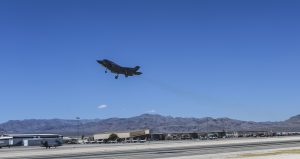2017-03-18 By Lt. General (Retired) David Deptula
Our military situation today is stark. The United States faces a burgeoning number, and a greater spectrum of threats around the globe. At the same time we have declining resources allocated to meeting these threats.
To successfully confront this dynamic array of dangers, we must optimize our military organizations and concepts of operation.
We must evolve service relationships from ones of interoperability—a goal of the Goldwater-Nichols Act, to ones of full integration and interdependency.
This is the next step in the evolution of our military.
A dollar spent on duplicative capability comes at the expense of essential capacity or capability elsewhere.
Confused organizational structures lead to sub-optimal employment of forces already stretched too thin. Outdated service roles, missions, and concepts of operation yield costly, inefficient acquisition programs.
Clearly, things have to change—security circumstances and fiscal pressures will no longer tolerate such conditions.
We are not going to be able to blast or buy our way out of these challenges—we are going to have to think our way out of them.
I believe that if the United States is to succeed in protecting its core interests around the globe and deter aggression, we must have the strongest Army, Navy, Marine Corps, and Air Force in the world.
However, fiscal realities dictate that the military must make difficult choices in balancing near-term operational readiness with longer-term needs.
This demands much more clarity regarding goals and desired outcomes, with special emphasis on how we can best project effective, prudent power to negate threats that would oppose us in the 21st century.
 It is time to change and to focus on con-ops innovation to drive strategy. Linking operations across all domains with accurate information can be the basis for an omnipresent security complex that is self-forming, and if attacked, self-healing. Credit Image: Bigstock
It is time to change and to focus on con-ops innovation to drive strategy. Linking operations across all domains with accurate information can be the basis for an omnipresent security complex that is self-forming, and if attacked, self-healing. Credit Image: Bigstock
Our Department of Defense and military services are conservative institutions.
While highly capable they are slow to change, but to operate effectively in the information age, we must develop and capitalize on the new concepts of operation and organizations that new technologies enable.
Dr. Thomas Kuhn, renowned American physicist, historian and philosopher, noted institutions only accept new paradigms when: 1) there is a paradigm crisis; 2) the old people of a given paradigm die off; or 3) change is forced from the outside.[1] We want to change before a crisis occurs, and cannot afford to wait for the “old-guard” to depart.
In 1986 Congress was the outside institution that forced much needed change in the Department of Defense with the Goldwater-Nichols Act.
It may be time to consider such action again.
I commend Chairman Cotton, Senator King, and the rest of the Airland Subcommittee for beginning this conversation and initiating this series of hearings regarding the future of all arms warfare in the 21st century. It is a much-needed start.
I believe the biggest challenge our defense establishment faces is one of institutional inertia.
We are well into the information age, yet our systems, organizations, and concepts of operations remain rooted in the industrial age of warfare.
Our diplomatic, economic, and informational elements of our national security enterprise are also largely unchanged since the mid 20th century, and require more integration than ever before.
We can no longer afford this misalignment—not only is it costly, but it also poses undue risk.
Change with respect to the military involves four principal factors—advanced technologies, new concepts of operation, organizational change, and the human dimension.
Advanced technologies and the new capabilities they yield, enable new concepts of operation that produce order-of-magnitude increases in our ability to achieve desired military effects.
Organizational change codifies changes and enhances our ability to execute our national security strategy.
The final and essential element to progress is the human dimension.
People are fundamental to everything we do, especially when it comes to leadership.
The 21st Century Security Environment
First, our defense strategy must contend with non-state and transnational actors; a rising economic and military powerhouse in China; a resurgent Russia; declining states—some with nuclear weapons; the increasing likelihood of nuclear weapons proliferation; evil actors of the most despicable nature; and a dynamic web of terrorism.
Second, the pace and tenor of our lives has been irrevocably altered by the acceleration of change.
Global trade, travel, and telecommunications have produced major shifts in the way we live.
Such developments are not isolated. Speed and complexity have merged, and now permeate the conduct of warfare. Consequently, one implication for future air and land warfare operations is that they must be able to respond rapidly and decisively anywhere on the globe at any time.
As recent events have demonstrated, key security events now unfold in a matter of hours and days, not months or years.
The window to influence such circumstances is increasingly fleeting.
Third, we have to contend with increasing personnel and procurement costs at a time when defense budgets are decreasing. Therefore, the provision of flexibility of response across a wide spectrum of circumstances should be foremost among the decision criteria we apply to our future military.
Fourth, we should acknowledge that deploying large numbers of American military forces onto foreign soil to nation-build vice accomplishing a defined mission and then leaving is counter-productive to securing our goals.
Strategies centered upon occupation expose America’s vulnerabilities, often result in anti-American backlash and domestic disapproval, and create destabilizing effects within the very state or region they are intended to secure.
Fifth, we must actively pursue and invest in options we can use to counter the increasingly advanced anti-access strategies and technologies our adversaries are developing.
Precision weapons and stealth projected incredible lethality at the end of the Cold War. Those capabilities proliferated, and our adversaries are now equipping themselves with these systems, and seeking greater advancements. One quarter of a century later, it is foolhardy to assume U.S. forces will be afforded freedom of action in future engagements. Our strategies, planning assumptions, acquisition programs, and training need to account for more capable enemies.
Sixth, we need to challenge our adversaries’ domination of public perception. We have to learn how to use the application of accurate, compelling information as a core element of our security apparatus.
 An F-35B Lightning II with Marine Fighter Attack Squadron (VMFA) 121 takes off during exercise Red Flag 16-3 at Nellis Air Force Base, Nev., July 20. This is the first time that the fifth generation fighter has participated in the multiservice air-to-air combat training exercise. (U.S. Marine Corps photo by Lance Cpl. Harley Robinson/Released)
An F-35B Lightning II with Marine Fighter Attack Squadron (VMFA) 121 takes off during exercise Red Flag 16-3 at Nellis Air Force Base, Nev., July 20. This is the first time that the fifth generation fighter has participated in the multiservice air-to-air combat training exercise. (U.S. Marine Corps photo by Lance Cpl. Harley Robinson/Released)
We are woefully inept at strategic communications and too often put ourselves in a reactionary versus proactive position in struggling to gain domestic and international public support.
Finally, information’s value also extends past the media. Just as wireless connectivity, personal computing devices, and cloud-based applications are revolutionizing life in the civilian sector; these trends are also altering how our military forces project power. Faster and more capable networks and computing capabilities are turning information into the dominant factor in modern warfare.
We need to understand that aircraft like the F-22 and F-35 are information systems far above and beyond being fighters that shoot missiles and drop bombs—they are sensor-shooters. F-22 operations over Syria validate this statement.
Given this reality, we must now acknowledge that information and its management are just as important today as the traditional tools of hard military power—airplanes, satellites, infantry, warships.
Information is the force evolving all weapon systems from isolated instruments of power into a highly integrated enterprise where the exchange of information and data will determine success or failure in the 21st century.
These facts have major implications throughout the military enterprise, particularly air and land operations—shaping key areas like doctrine, organization, training, materiel acquisition and sustainment, along with command and control.
Top leaders in the policy community must adjust to the new realities of information age combat operations. Cold War and counterinsurgency paradigms will fall short when building, sustaining and employing military power in the modern era.
These trends provide a starting point for anticipating the future with which we will have to contend.
Bluntly stated, all the services, Department of Defense (DOD) agencies, and the other elements of our national security architecture have been slow to recognize the emerging new security environment.
Our focus has remained on traditional weapons platforms. We still have institutions and processes that were designed in the middle of the last century to accommodate what we now view—in retrospect—as a rather simple world of kinetics and traditional domains that characterized the Cold War.
 Will the United States and its allies shape a credibility defense strategy in the Pacific to reduce the nuclear threat? Or will growing threats to Japan lead Japan to join the nuclear club? Credit Image: Bigstock
Will the United States and its allies shape a credibility defense strategy in the Pacific to reduce the nuclear threat? Or will growing threats to Japan lead Japan to join the nuclear club? Credit Image: Bigstock
While nuclear threats have not gone away, we need to supplement our traditional focus on combined arms warfare with a broader “lens” that exploits non-kinetic tools and the cyber domain.
Excessive emphasis on traditional weapon platforms associated with combined arms warfare runs the danger of under-investing in emerging non-kinetic instruments.
We cannot relive the era of battleship admirals and cavalry generals that dismissed aviation as a passing fad.
Summarizing, the proliferation of technology, information flow, and the associated empowerment of nation-states, organizations, as well as individuals, presents one of the most daunting challenges our military has ever faced.
Editor’s Note: This has been excerpted by Lt. General (Retired) Deptula’s testimony before the Senate Armed Services Subcommittee on Airland, March 15, 2017
https://www.armed-services.senate.gov/imo/media/doc/Deptula_03-15-17.pdf
[1] Thomas S. Kuhn, The Structure of Scientific Revolutions, University of Chicago Press, 1962.


